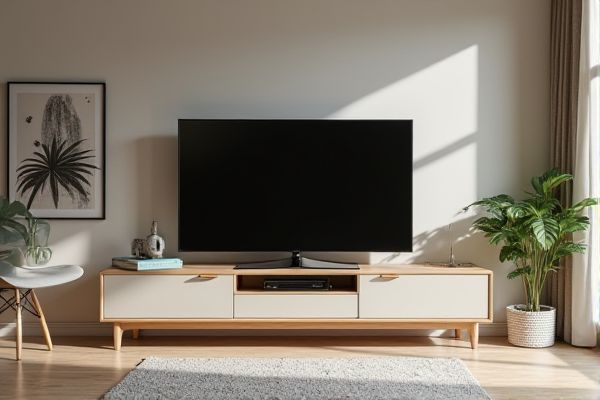
A media console typically offers more storage options and cable management for electronic devices compared to a TV stand, which often focuses solely on supporting the television itself. Explore the rest of this article to discover which choice best suits your space and entertainment needs.
Table of Comparison
| Feature | Media Console | TV Stand |
|---|---|---|
| Primary Purpose | Houses media devices and accessories | Supports and displays the TV |
| Storage | Multiple shelves, drawers, and cabinets for devices, DVDs, remotes | Limited or no storage, mainly flat surface |
| Size | Larger, designed to accommodate various media equipment | Smaller and compact, focused on TV size |
| Design | Often bulkier; blends with entertainment center setups | Sleeker, minimalistic design emphasizing TV |
| Weight Capacity | High, supports TVs plus additional devices | Moderate, supports only the TV |
| Cable Management | Integrated cable management systems | Basic or no cable management features |
| Material | Wood, MDF, metal, or combination | Wood, metal, glass, or minimal materials |
| Cost | Generally higher due to storage and size | Usually lower, simpler design |
Introduction: Media Console vs TV Stand
A media console offers versatile storage options with compartments for electronics, DVDs, and gaming devices, while a TV stand primarily provides a surface to support your television. Media consoles often feature cable management systems and adjustable shelving, enhancing organization and aesthetic appeal compared to traditional TV stands. Choosing the right option depends on your need for functionality, space, and the style that complements your living area.
Definition and Purpose of a Media Console
A media console is a versatile piece of furniture designed to house audio-visual equipment, gaming consoles, and media accessories while providing cable management and adequate ventilation. It often includes shelves, drawers, or compartments tailored for electronic devices, optimizing organization and functionality. Unlike a simple TV stand, a media console emphasizes multimedia storage and connectivity, enhancing the overall entertainment experience.
What is a TV Stand?
A TV stand is a piece of furniture designed specifically to support and elevate your television, often featuring shelves or compartments for media devices, gaming consoles, and storage. Unlike a media console, a TV stand typically prioritizes functionality and stability to hold the TV at an optimal viewing height without extensive storage options. Your choice between a TV stand and media console depends on the balance you want between display space and storage capacity.
Design and Aesthetic Differences
Media consoles typically feature a minimalist, modern design with closed storage compartments and cable management systems that keep electronics organized and out of sight. TV stands often prioritize open shelving to display media devices and decorative items, offering a more traditional or casual aesthetic. The choice between the two depends on the desired balance between sleek, clutter-free appearance and accessible, visible storage.
Storage and Organization Features
A media console offers enhanced storage and organization features compared to a traditional TV stand, often including multiple shelves, drawers, and compartments to neatly house gaming consoles, DVDs, and remote controls. Built-in cable management systems in media consoles help reduce clutter by concealing wires, improving the overall aesthetic of your entertainment area. Choosing a media console will help you maximize space efficiency while keeping all your media accessories accessible and well-organized.
Material and Build Quality Comparison
Media consoles often feature more robust construction with solid wood, engineered wood, or metal frames designed to support heavier AV equipment and provide better ventilation. TV stands may utilize lighter materials like MDF or particleboard, which can compromise durability but offer more affordable options for casual use. Choosing your furniture based on material quality ensures stability and longevity, especially if you have multiple media devices or heavier TVs.
Space and Size Considerations
When comparing media consoles and TV stands, space and size considerations are crucial for optimizing your living area. Media consoles often provide more storage options with larger dimensions, making them ideal for housing multiple devices and accessories, while TV stands typically focus on supporting your television with a compact footprint. Choosing the right unit depends on your room size, the amount of equipment you need to accommodate, and your desired balance between functionality and space efficiency.
Cable Management Solutions
Media consoles typically offer advanced cable management solutions with built-in compartments, grommets, and hidden channels designed to organize and conceal wires efficiently. TV stands generally provide more basic cable management features, often limited to rear openings or minimal cable clips, which can result in visible clutter. Choosing a media console enhances the aesthetic appeal and functionality of home entertainment setups by keeping cables neatly tucked away and reducing tangled wires.
Price Range and Budget Options
Media consoles typically range from $150 to $800, offering versatile budget options from simple designs to premium models with storage features. TV stands generally fall between $100 and $400, making them a more affordable choice for those seeking basic functionality. Both options provide cost-effective selections, but media consoles often include additional compartments justifying higher prices.
Which is Best for Your Home Entertainment Needs?
A media console offers versatile storage options for your AV components, game consoles, and accessories, often featuring cable management and adjustable shelves to keep your setup organized. A TV stand typically prioritizes sturdier support and aesthetic integration for your television, sometimes providing more open space but less dedicated media storage. Choosing between a media console and a TV stand depends on whether your priority is maximizing storage and organization or emphasizing sleek, stable TV placement for your home entertainment space.
 homyna.com
homyna.com